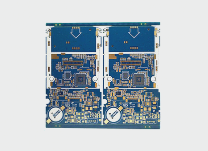1. **FPC Shape and Hole Processing Technology:**
Presently, punching stands out as the predominant method for batch processing of FPC, while CNC drilling and milling serve smaller batches and samples. However, these traditional techniques struggle to meet evolving dimensional and positional accuracy standards. Hence, emerging technologies such as laser etching, plasma etching, and chemical etching are gaining traction. Among these, chemical etching boasts exceptional positional accuracy alongside high efficiency and cost-effectiveness in mass production. Nonetheless, these methods are typically integrated with punching rather than employed in isolation.
2. **FPC Guide Holes (Positioning Holes):**
Hole processing, though typically a standalone procedure, necessitates guide holes for alignment with the circuit pattern. While automated CCD camera systems can directly detect positioning marks, their cost and limited applicability render them uncommon. Instead, the prevalent approach involves drilling positioning holes based on copper foil markings. Though not novel, this method significantly enhances accuracy and production efficiency. Notably, high-precision punching is employed to process these positioning holes, minimizing debris and enhancing accuracy.
3. **FPC Punching:**
Punching entails utilizing specialized molds to shape holes via hydraulic or crank presses. The array of available molds often extends to other processes, enhancing versatility.
4. **FPC Milling Processing:**
Milling processing boasts brief processing times, typically measured in seconds, offering cost-effective solutions. Conversely, mold production proves costly and time-intensive, hindering adaptability to rapid prototyping and design iterations. The immediate operability afforded by CNC milling, when accompanied by CAD data, mitigates this challenge. Notably, processing duration directly impacts costs, with extended processing times translating to higher expenses. Hence, integrated adjustment processing proves optimal for low-volume, high-value products or short trial production runs.
Presently, punching stands out as the predominant method for batch processing of FPC, while CNC drilling and milling serve smaller batches and samples. However, these traditional techniques struggle to meet evolving dimensional and positional accuracy standards. Hence, emerging technologies such as laser etching, plasma etching, and chemical etching are gaining traction. Among these, chemical etching boasts exceptional positional accuracy alongside high efficiency and cost-effectiveness in mass production. Nonetheless, these methods are typically integrated with punching rather than employed in isolation.
2. **FPC Guide Holes (Positioning Holes):**
Hole processing, though typically a standalone procedure, necessitates guide holes for alignment with the circuit pattern. While automated CCD camera systems can directly detect positioning marks, their cost and limited applicability render them uncommon. Instead, the prevalent approach involves drilling positioning holes based on copper foil markings. Though not novel, this method significantly enhances accuracy and production efficiency. Notably, high-precision punching is employed to process these positioning holes, minimizing debris and enhancing accuracy.
3. **FPC Punching:**
Punching entails utilizing specialized molds to shape holes via hydraulic or crank presses. The array of available molds often extends to other processes, enhancing versatility.
4. **FPC Milling Processing:**
Milling processing boasts brief processing times, typically measured in seconds, offering cost-effective solutions. Conversely, mold production proves costly and time-intensive, hindering adaptability to rapid prototyping and design iterations. The immediate operability afforded by CNC milling, when accompanied by CAD data, mitigates this challenge. Notably, processing duration directly impacts costs, with extended processing times translating to higher expenses. Hence, integrated adjustment processing proves optimal for low-volume, high-value products or short trial production runs.



